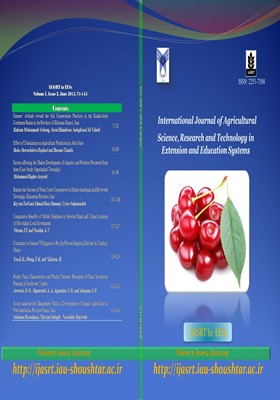The main purpose of this study is identifying strategies for agricultural sustainable development in Iran. This research is a mixed exploratory research and has been carried out in a combination of qualitative and quantitative parts. In the qualitative part, various met
More
The main purpose of this study is identifying strategies for agricultural sustainable development in Iran. This research is a mixed exploratory research and has been carried out in a combination of qualitative and quantitative parts. In the qualitative part, various methods such as semi-structured interviews and focus group techniques were used. In a quantitative part, the population of the study consisted of wheat farmers of Khouzestan province, Iran. The stratified random sampling method was selected as the research sampling method. In order to formulate strategic planning, the model of analysis of Strengths, Weaknesses, Opportunities and Threats (SWOT) was used. Also, in the quantitative part of the research through Structural Equation Model (SEM), the role of the identified strategies was evaluated and the designed model was approved. Based on the results, it can be found that the predictive positive effect of WO1 (β=0.512, t-value=3.453, p<0.001), WO2 (β=0.533, t-value=3.516, p<0.001), WO3 (β=0.581, t-value=4.129, p<0.001), WO4 (β=0.916, t-value=5.821, p<0.001), WO5 (β=0.861, t-value=4.523, p<0.001), WO6 (β=0.823, t-value=5.123, p<0.001), WO7 (β=0.694, t-value=5.212, p<0.001), WO8 (β=0.761, t-value=4.928, p<0.001), WO9 (β=0.832, t-value=5.257, p<0.001) and WO10 (β=0.621, t-value=4.153, p<0.001) on the ASD. Based on the results, the amount of R2=0.74 was estimated. This indicates that 10 strategies and 34 construct have the ability to explain 74% of the ASD variance. Based on the results obtained, the overall goodness of the fitting statistics showed that the structural model is well consistent with the data. The designed strategic plan can play an effective role in the sustainable development of agriculture.
Manuscript profile


